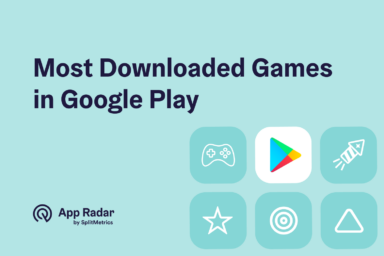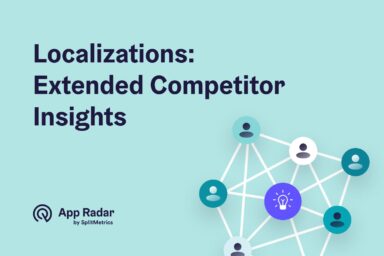iOS App Product Page Localization: How to Use it the Right Way to Improve ASO
App Store product page localization means adapting text and visuals to a market’s language and culture so the page feels local and relevant. It also requires meeting Apple’s technical and policy guidelines for iOS product pages. This article explains what matters most for App Store localization and how to apply it in practice to effect app store optimization (ASO) and organic visibility in App Store.

What are thebasics of AppStore productpage localization?
App Store product page localization is managed in App Store Connect, where developers add languages and localized metadata for iOS, iPadOS, macOS, watchOS, and tvOS apps. App Store Connect is also where teams submit apps, manage metadata, set pricing, and monitor performance analytics.
Product page localization in the App Store follows the same principles as Google Play, as described in our general guide on “How to localize your app and reach a global audience.” This article will focus on App Store-specific aspects of localization.
Whatare the technicalprinciples ofApp Store productpage localization?
App Store product page localization requires localizing all store-facing metadata for each locale – app name, subtitle, description, promotional text, and the keyword field – prior to submitting a version or metadata update.
- App Store Connect exposes a keyword field per locale to tailor discoverability to local search behavior.
- The App Store supports locale-specific screenshots and app previews so creatives can reflect language and cultural norms.
- The app icon is global and does not vary by locale or custom product page.
- Locales and storefronts are not one-to-one; some locales such as English (U.K.) serve multiple country storefronts.
Please refer to Apple developers’ pages for a complete list of App Store localizations. Many localizations have English (U.K.) as their primary language, and additional languages are sometimes available.

How do locales and localizations work in App Store?
Each app submitted to the App Store has a primary language and can have multiple localizations.
The primary language will be displayed to all locales for which you do not offer a localized version of your product page. Additional localized versions of your app will be shown to users in their locale.
Additionally, some locales support additional languages. How does this work? Let’s consider the example of the United States and China:
| ISO code | Country or region | Default language | Additional supported language(s) |
| USA | United States | English (U.S.) | Arabic, Chinese (Simplified), Chinese (Traditional), French, Korean, Portuguese (Brazil), Russian, Spanish (Mexico), Vietnamese |
| CHN | China mainland | Simplified Chinese | English (U.K.) |
In the United States, the algorithm indexes keywords from both English (U.S.) (the primary language) and Spanish (Mexico). So, if your primary language is English (U.S.), you can include relevant Spanish (Mexico) keywords in your Spanish (Mexico) localization to increase your app’s discoverability for Spanish-speaking users in the US.
If you set Simplified Chinese as the default language on the Chinese mainland, your app will be indexed in China, Singapore, and the United States. Setting English (U.K.) will make your app visible in all 175 locales.
What is the full scope of localizing an app's product page?
The full scope of an app’s product page localization on the App Store includes translating all relevant metadata & assets. However, a successful localization goes beyond translations and strives to establish a genuine connection with a target audience by making the depth of changes to content more culturally relevant. For example:

Be prepared to embrace different color schemes for your product page images. Image source: the App Store, fetched with SplitMetrics Acquire’s CPP Intelligence.
As mentioned, App Store product page localization follows the same principles as Google Play, relying on cultural relevance and nuance to provide the best possible user experience.
The main differences between localization of App Store vs Google Play apps are:
- Demographic differences: The same app may have a slightly different demographic on the App Store and Google Play, resulting from different demographics between the two systems. These may impact how some design choices are perceived, and we’d highly recommend approaching each marketplace’s ASO individually.
- UX differences: A llok at the App Store’s product page and Google Play’s listing shows general similarity but with significant differences, especially concerning how app screenshots are presented. In our experience, built on many A/B tests and experiments, screenshots are the most important visual asset on the App Store.
Approach localization individually on the App Store and Google Play, remembering what’s important and which elements create the first impression.
While not every app may benefit from a preview video, every single app will benefit from optimized screenshots. Again, differences in how users interact with assets on a product page or a store listing suggest that an individual approach to localization & ASO is necessary for the App Store and Google Play.
Consequently, a professional product page localization may involve:
- Translating all app metadata, both textual and visual
- Taking an entirely different approach to writing the app’s name, subtitle, promotional text, and description
- Re-designing app screenshots entirely, with different colors, elements in focus, text density, game characters, symbols, etc.
- Re-designing, removing, or adding an app preview video;
While translating metadata may seem simple, straightforward, and sufficient, we’d encourage all app developers to explore a more in-depth approach on the App Store because it will enhance performance.

What are the main benefits of app localization?
The benefits of app localization are
- Improved discoverability via localized keywords and metadata tailored to each market.
- Higher tap-through rates when listings appear in a user’s primary language.
- Higher conversion rates from clearer, locally relevant messaging and visuals.
- Greater chance of editorial featuring in local App Store collections.
- More positive ratings and reviews from users who feel understood.
- Lower acquisition costs as organic visibility and conversion improve.
- Faster entry into new markets by establishing a credible local presence.
A localized product page is a crucial first step in entering new international markets. It helps you establish a presence and attract local users from the outset.
- Improved Tap-through rates (TTR): Users are more likely to tap on search results or apps presented elsewhere on the App Store when presented in their primary language.
- Higher conversion rates (CR): Similarly, a properly localized product page will help users better understand the app’s value proposition in their primary language, increasing the likelihood of a download.
- Increased visibility in local App Store features and collections: App store editorial teams often feature apps that provide users with a high-quality, localized experience. A well-localized product page increases your chances of being featured in local selections.
- Potential for higher ratings and reviews: Users who feel understood and catered to are more likely to leave positive ratings and reviews in their language, further enhancing your app’s reputation in that market.
Localization is crucial to gaining a competitive advantage in all markets. Many developers neglect thorough product page localization or do not go above the bare minimum, creating opportunities for those willing to invest in it.
Likewise, like any ASO tactic that improves organic visibility and conversion rates, localization is crucial to optimizing user acquisition costs.

What are the benefits of localization? Find out how World of Warships Blitz gained a 35% average increase in app store impressions across various locales with App Radar’s AI-backed keyword research & optimization.
What are best practices for localizing iOS apps?
To get the most value from app localization, follow these best practices:
- Start with ASO competitive research, as it should give you an understanding of ongoing trends and preferences in a target market. Make sure to include popular, local apps, as they’d probably serve as best benchmarks.
- Create an individual ASO strategy for the App Store: Solutions from Google Play may not work on the App Store, because of different demographics and user experience each marketplace provides, shaping user behavior and how they interact with product pages and store listings.
- Run a thorough keyword research: Each market is a unique environment, with different competitors and trends regarding keywords. For example, it’s probable that users in Japan will look just for “rpg” games instead of “jrpg”. Each localization has its keyword field, use it to your maximum advantage.
- Prioritize visual assets in localization: Visual assets, especially screenshots are essential to optimizing conversion rates on the App Store. They’re presented differently and allow various creative approaches to design. Take it into consideration while planning localization.
- Remember about seasonality and festive periods on other markets. Localization means adjusting to local preferences, but markets outside your own are also subject to seasonality or have important festive periods that influence app marketing. This may mean planning an update for the Golden Week in Japan, or New Year in China.
- Analyze feedback & implement changes: Analyzing user reviews will help you correct any missteps and improve your localization. You’ll get a glimpse of a natural, native language used by users to describe your app and those similar to yours.
- Apply the multi-index localization strategy to increase your visibility. Remember that App Store locales support more than one language. Use it to your advantage if you don’t plan international expansion, but want to reach more diverse audiences in your market. This way, you’ll gain more space for keyword optimization.
- Follow the minimum viable localization (MVL) approach. Always align your product page and app localization by gradually applying changes to elements that are likely to make the most impact.
Localization most likely will be an iterative process simply because its success relies on careful research which takes time. In the beginning, it’s acceptable to simply translate your product page’s visual assets and other metadata and move on to gradual, iterative introduction of more culturally relevant elements when your in-app content will be ready for it.

Remember: You can simplify your keyword research and localization by using the keyword auto-translation feature in App Radar’s all-in-one ASO tool.
How App Radar enhances localization strategy and management
App Radar makes the process of app localization incredibly easy and effective.
Strategic product page localization requires a thorough research of keywords, competitors, and good understanding of a given market’s trends and preferences: on a general, cultural level, as well as in a way unique to each app category or genre.
App Radar provides extensive market intelligence features, including Competitor Localizations, which will give you an overview how your key competitors localize apps for different markets.
ASO Benchmarks will allow you to analyze trends on app category level, comparing approach to handling metadata and optimizing visual assets.

App Creatives Library will let you find in-app events and explore product page creatives on all markets, a key component for advancing your localization strategy to incorporate more culturally-relevant elements and seasonal or event-related marketing.
Finally, our new, improved, and AI-driven Keyword Research will let you explore all locally relevant keywords for proper metadata localization.

Even more, App Radar will allow you to manage all localization through API integration with App Store Connect. You’ll be able to edit metadata for multiple localizations in one go and access all our competitor insights in one place, saving time and money in the process.
Final words
Strategic localization relies on research and App Radar has all the tools to make it possible for all developers and publishers. It takes effort, but can be worked on in steps, gradually reaching more local and cultural relevance, further improving tap-through and conversion rates. For all the effort, localization brings significant reward, which is even greater when approached with a sophisticated tool such as App Radar.
Latest Posts



